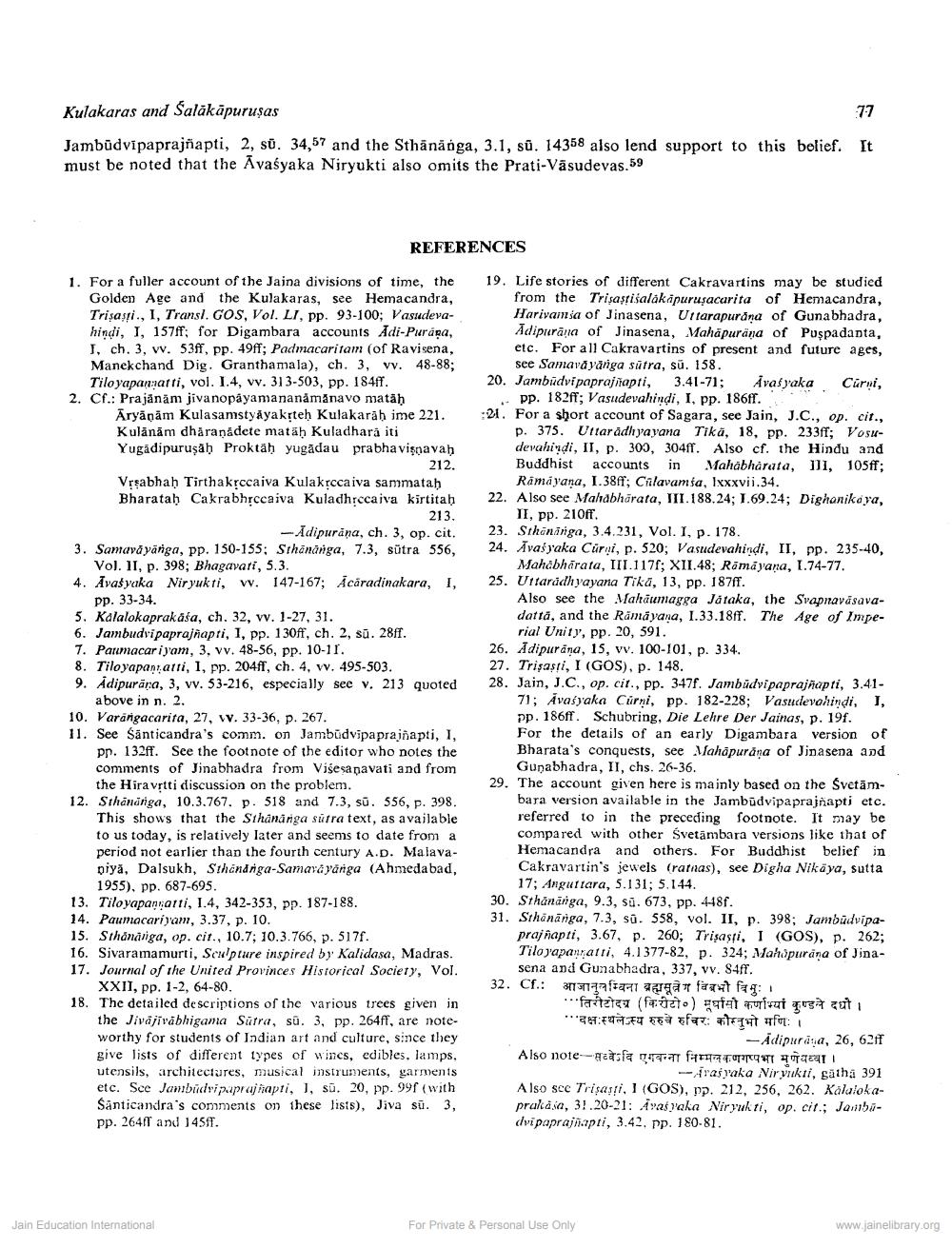________________
Kulakaras and Salākāpuruşas
Jambūdvīpaprajñapti, 2, sū. 34,57 and the Sthānānga, 3.1, sū. 14358 also lend support to this belief. It must be noted that the Avaśyaka Niryukti also omits the Prati-Vasudevas 59
REFERENCES
1. For a fuller account of the Jaina divisions of time, the
Golden Age and the Kulakaras, see Hemacandra, Trişasti., I, Transl. GOS, Vol. LI, pp. 93-100; Vasudevahindi, I, 157ff; for Digambara accounts Adi-Puraga, T. ch. 3, v. 53ff, pp. 49ff; Padmacaritam (of Ravisena, Manekchand Dig. Granthamala), ch. 3, vv. 48-88;
Tilo yapannatti, vol. 1.4, vv. 313-503, pp. 184ff. 2. Cf.: Prajánām jivanopayamananämänavo matah
Āryānām Kulasamstyayakrteh Kulakarah ime 221. Kulānām dhåranadete matäh Kuladhara iti Yugādipuruṣaḥ Proktah yugādau prabha vişoavah
212. Vrsabhah Tirthakrccaiva Kulakrocaiva sammatah Bharatah Cakrabhrccaiva Kuladhrccaiva kirtitaḥ
213.
- Adipurana, ch. 3, op. cit. 3. Samavāyanga, pp. 150-155; Sthānanga, 7.3, sütra 556,
Vol. II, p. 398; Bhagavati, 5.3. 4. Avasyaka Niryukti, v. 147-167; Acaradinakara, I,
pp. 33-34. 5. Kalalokaprakaśa, ch. 32, vv. 1-27, 31. 6. Jambudvi paprajnapri, 1, pp. 130ff, ch. 2, sū. 28ff. 7. Paumacar iyam, 3, vv. 48-56, pp. 10-11. 8. Tiloyapantati, I, pp. 204ff, ch. 4, v. 495-503. 9. Adipurāra, 3, vv. 53-216, especially see v. 213 quoted
above in n. 2. 10. Varangacarita, 27, w. 33-36, p. 267. 11. See Sänticandra's comm. on Jambūdvipaprajnapti, I,
pr. 132ff. See the footnote of the editor who notes the comments of Jinabhadra from Visesanavati and from
the Hira vrtti discussion on the problem. 12. Sthānäriga, 10.3.767. p. 518 and 7.3, sū. 556, p. 398.
This shows that the Sthânăriga sutra text, as available to us today, is relatively later and seems to date from a period not earlier than the fourth century A.D. Malavapiya, Dalsukh, Sthandriga-Samara yanga (Ahmedabad,
1955), pp. 687-695. 13. Tiloyapanranti, 1.4, 342-353, pp. 187-188. 14. Paumacari yam, 3.37, p. 10. 15. Sthânäriga, op. cit., 10.7; 10.3.766, p. 517f. 16. Sivaramamurti, Sculpture inspired by Kalidasa, Madras. 17. Journal of the United Provinces Historical Society, Vol.
XXII, pp. 1-2, 64-80. 18. The detailed descriptions of the various trees given in
the Jivajivabhigama Sutra, su. 3, pp. 264ff, are noteworthy for students of Indian art and culture, since they give lists of different types of wincs, edibles. lamps, utensils, architectures, musical instruments, garments etc. Sce Jambūdvipuprajnapti, I, sū. 20, pp. 995 (with Santicandra's comments on these lists), Jiva sū. 3, pp. 26411 and 145fT.
19. Life stories of different Cakravartins may be studied
from the Trisasrišalákāpuruşacarita of Hemacandra, Harivam sa of Jinasena, Uttarapurana of Gunabhadra, Adipurā ia of Jinasena, Mahapuräna of Puşpadanta, etc. For all Cakravartins of present and future ages,
see Samavā yåriga sūtra, sū. 158. 20. Jambūdvi paprajñapti, 3.41-71; Åvas yaka Cürni,
pp. 182ff; Vasudevahindi, I, pp. 186ff. :21. For a short account of Sagara, see Jain, J.C., op. cit.,
p. 375. Uttaradhyayana Tikā, 18, pp. 233ff; Vosudevahindi, II, p. 303, 304ff. Also cf. the Hindu and Buddhist accounts in Mahabharata, DI, 105ff;
Ramayana, I.38ff; Calavamsa, Ixxxvii.34. 22. Also see Mahabharata, III.188.24; 1.69.24; Dighonikaya,
II, pp. 210ff. 23. Sthônănga, 3.4.231, Vol. I, p. 178. 24. Avašyaka Cürņi, p. 520; Vasudevahindi, II, pp. 235-40,
Mahabharata, II1.1177, XII.48; Rāmāyana, 1.74-77. 25. Uttaradhyayana Tikā, 13, pp. 187ff.
Also see the Mahāumagga Jataka, the Swapnavāsavadatta, and the Rāmāyana, I.33.18ff. The Age of Impe
rial Unity, pp. 20, 591. 26. Adipurana, 15, vv. 100-101, p. 334. 27. Trişasti, I (GOS), p. 148. 28. Jain, J.C., op. cit., pp. 347f. Jambūdvi paprajnapti, 3.41 -
71; Avasyaka Cürni, pp. 182-228; Vasudevahindi, T, pp. 186ff. Schubring, Die Lehre Der Jainas, p. 19f. For the details of an early Digambara version of Bharata's conquests, see Mahāpurana of Jinasena and
Gunabhadra, II, chs. 26-36. 29. The account given here is mainly based on the Svetām
bara version available in the Jambūdvipaprajnapti etc. referred to in the preceding footnote. It may be compared with other Svetāmbara versions like that of Hemacandra and others. For Buddhist belief in Cakravartin's jewels (ratnas), see Digha Nikaya, sutta
17; Anguftara, 5.131; 5.144. 30. Sthånārga, 9.3, sū. 673, pp. 448f. 31. Sthânănga, 7.3, sů. 558, vol. II, p. 398; Jambūdvipa
prajnapti, 3.67, p. 260; Trisasti, I (GOS), p. 262; Tilo yapannatti, 4.1377-82, p. 324; Mahópurana of Jina
sena and Gunabhadra, 337, vv. 84ff. 32. Cf.: 3750747119
faut fag fatza (foto) atat futai qua cut 39: 34 T6 : *
:
-Adipurana, 26, 62ff Also note---afa TeraT FATTOTETT cal!
--Aras raka Nirynkti, sàtha 391 Also see Trisarri, I (GOS), pp. 212, 256, 262. Kalalokaprakasa, 31.20-21: Ayaraka Nir yuk ti, op. cit.; Joubidvi paprajnapti, 3.42, pp. 180-81.
Jain Education International
For Private & Personal Use Only
www.jainelibrary.org




